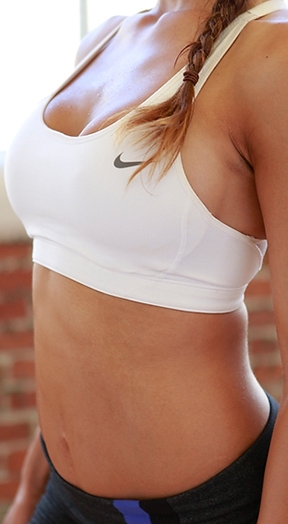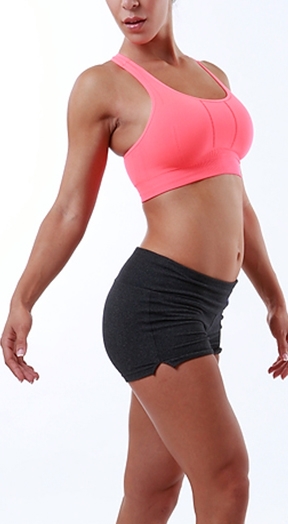There is no plastic surgery procedure that can be tailored specifically to the needs and desires of the patient to the degree of breast augmentation. With the wide range of breast implant options that are available to patients today, there are many different types of breast implants that can be selected, allowing surgeons to place an implant that is the most ideal choice for the individual patient. The implant’s size, amount of forward projection, shape, surface, and filler solution are all options that heighten the ability to personalize the procedure based on the patient’s anatomy and goals. Bay Area surgeon John Griffin will help patients find the implant type that best suits them.
Fillers
Are saline or silicone gel breast implants right for you? Each of these filler solutions is associated with benefits and drawbacks.
Saline Breast Implants
The advantages of saline breast implants include:
- Shorter scars: Saline implants are filled after the implant shell is placed in the implant pocket. Thus, a smaller incision can sometimes be used.
- Less expensive: Saline implants are less expensive than silicone implants.
- Noticeable ruptures: When a saline implant tears and leaks, the problem is noticeable because the saline solution will drain out of the implant shell. As the body absorbs the saline solution, the implant completely deflates, resulting in noticeable asymmetry. Saline resorption does not hurt the patient.
The notable disadvantage of saline implants is that they do not look or feel as natural as silicone. This problem is less obvious when the implants are placed below the chest muscle. However, in thin women and those with less breast tissue, saline implants often do not offer as natural of a result.
Another disadvantage of saline implants is rippling. The saline implant shell is more likely to fold or ripple, an issue that can sometimes be seen or felt beneath the skin. Filling the implant shell to the appropriate level makes rippling less likely to occur and placing the implant under the chest muscle makes it less likely to be seen or felt.
Silicone Breast Implants
The advantages of silicone breast implants include a more natural appearance and the feel of the implants is closer to that of real breast tissue.
However, there are some disadvantages associated with silicone implants, including:
- Incision option limitations: Very large silicone implants can’t be placed easily through the areolar and transaxillary incisions.
- Longer scar: Implants arrive at the surgeon’s office pre-filled. Since the implants are filled before they are placed, a longer incision is required.
- More expensive: Silicone implant surgery is often expensive.
- Routine MRIs: Silicone implant ruptures are difficult to detect. Patients with silicone implants may choose to have MRIs so doctors can determine if a leak has occurred.
Size
Do you want larger or smaller sized breast implants? Breast implants are measured in cubic centimeters, and manufacturers produce implants in sizes ranging from 100cc to 800cc, increasing in increments of approximately 25cc. The most commonly chosen sizes are in the 300cc to 400cc range.
Dr. Griffin has many years of experience in helping patients choose the implant size that will produce a successful and desired surgical outcome. He will ask you about your aesthetic concerns, review photos of breast augmentation results with you, and have you try on different sized implants to gain a better understanding of your surgical goals. Patients can also preview potential surgical plans prior to breast augmentation surgery with Vectra technology, a 3D imaging system.
Profile
Though this concept is not as well-known to potential patients, breast implant profile plays an important role in the results of surgery. The profile refers to the base diameter of the implant, or how far the implant projects from the chest wall. A low profile implant has a wider base, while higher profiles have a narrower base. Generally, the profile type is selected based on the patient’s body type and the look she desires. A low profile may be recommended to a patient with a wider-frame or those who want more fullness in the mid to lower poles of the breasts. The higher profiles may be recommended to women with smaller frames or those who want more fullness in the upper pole of the breast.
Shape
While the size and profile of an implant can determine its shape, manufacturers have developed teardrop or textured form stable implants. They can have a distinct feel and look that some patients desire. There is risk of teardrop implant rotation, which can cause breast asymmetry. Patients can also choose the standard round implants that are most commonly used.
Implant Surface
Most breast implants have a smooth surface, which allows the implant to move around in the breast pocket. Smooth surface implants are the most popular choice.
Textured implants were designed to reduce the risk of capsular contracture and to prevent the implant from rotating in the breast pocket. However, studies haven’t conclusively shown that textured implants reduce the risk of capsular contracture.
Breast Implant Consultations
To schedule a consultation and discuss breast implant options, contact Dr. Griffin’s practice today.







